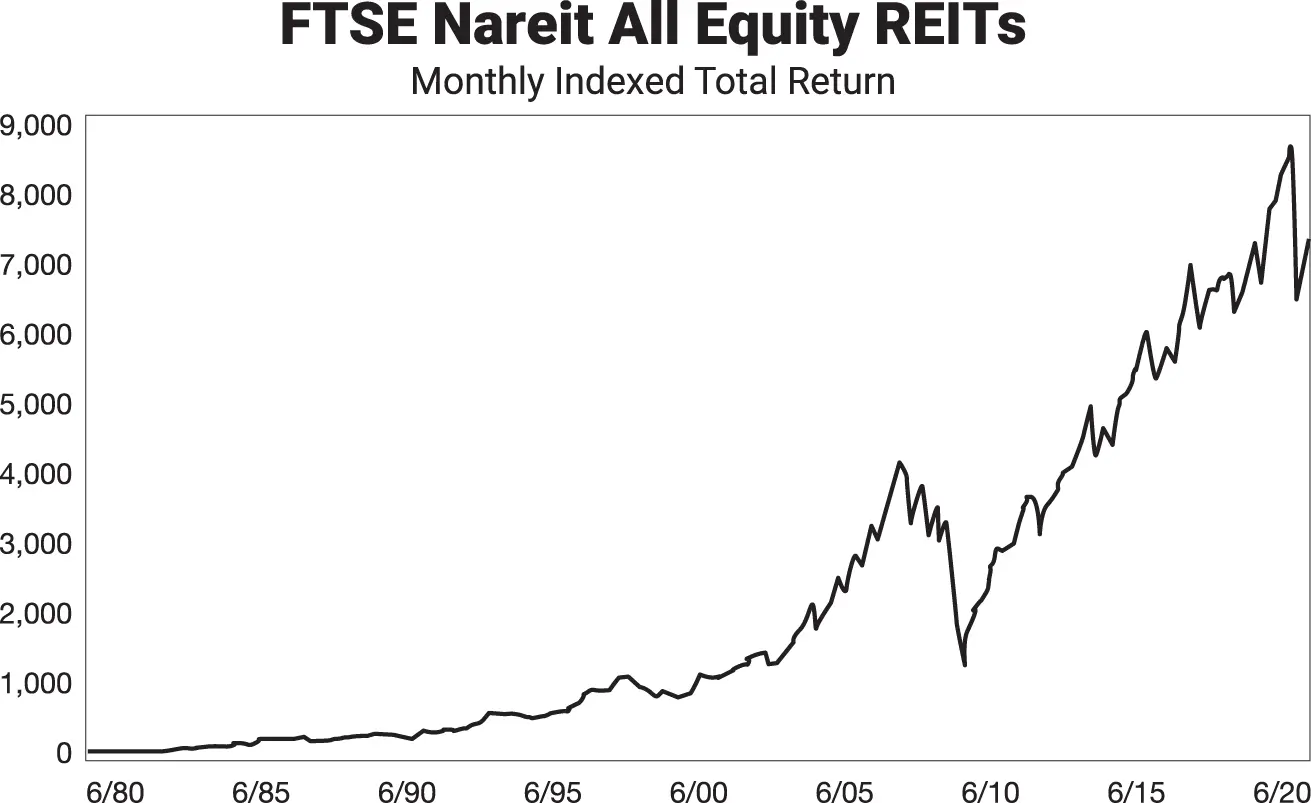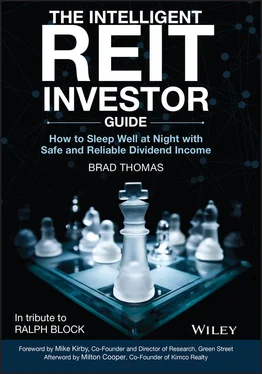They've since evolved into a highly attractive overall package that's very much worth considering: an uncomplicated way to buy and own real estate run by experienced professionals who give you some of the profits anyway. REITs offer access to reaping income from major office buildings, shopping malls, hotels, and apartment buildings. In fact, they work with just about any kind of commercial real property you can think of. Better yet, this all comes in an easily traded common stock like Apple or Amazon.
Perhaps best yet, they do all this while giving you the steady and predictable cash flows that come from owning and leasing real estate – and on a much larger scale than a mere individual can handle. Essentially, REITs put their corporate‐strength access to public equity and debt capital into acquiring and building additional properties to grow their businesses. Combined, these features can add stability to their investors’ portfolios.
Real estate as an asset class has long been perceived as an inflation hedge that, during most market periods, enjoys fairly low correlation with the performance of other categories.
As mentioned in the introduction, REITs have been around for 60 years now, though it's only been in the past 30 that they've become widely known. That's true because of several pivotal moments in their evolution, some of which were out‐and‐out crises at the time. We'll discuss those in more detail in Chapter 3, but suffice it to say for now that REITs evolved in very positive ways as a direct result of those experiences.
From the end of 1992 through the end of 2019, the size of the REIT industry has increased by more than 75 times, rising from a market cap just under $16 billion to almost $1.33 trillion. Since that's only about 10–15% of all institutionally owned commercial real estate, this extremely attractive sector is filled with vertically integrated operating companies that still have plenty of room to grow.
I've already mentioned that REITs are easy to buy and sell. But you're excused if you'd like to point out how unwieldy commercial real estate can be.
A liquid asset or investment is one with a generally accepted value and accommodating market, where it can be sold easily and quickly at little or no discount to that value. In which case, direct investment in real estate – whether a shopping mall in California or a major office building in Manhattan – is far from liquid. People aren't exactly lining up outside of such buildings ready to buy them at the drop of a hat.
Most publicly traded stocks, however, are liquid, a rule that holds true for REITs. They're real estate – owning investments that enjoy the benefit of a common stock's public market trading and liquidity. So when you buy into them, you're not just buying properties; you're also buying the businesses they belong to. It's like when you buy stock in Exxon; you're buying more than oil reserves.
The vast majority of REITs are public real estate companies overseen by financially sophisticated, skilled management teams with the ability to grow their companies’ cash flows (and dividends) at rates higher than inflation. It's not uncommon to get total annual returns of 8%. All you need is a 4% dividend yield and 4% capital appreciation resulting from 4% annual increases in operating cash flow and property values.
As we'll discuss in a later chapter, management and good corporate governance are critical to those kinds of results. Like other operating companies in the public market, REIT shares have a strong likelihood of increasing in value over time as their properties generate higher cash flows, the values of their properties increase, and they grow their portfolios – all of which management can, should and, in most cases, does add active value to.
Running a REIT isn't always a stress‐free job (especially in the face of a global pandemic and subsequent shutdowns). But there are teams of men and women out there nonetheless who knock it out of the park. They operate their properties to generate steady income, only accepting risk where the odds of success are high. Because they recognize REITs’ unique ins and outs, most of them are exceptionally careful when and where they invest retained earnings.
They search out ways to grow their property portfolios, values, and cash flows by taking advantage of new opportunities as they come along.
There are two basic categories of real estate investment trusts to consider. An equity REIT, for one, is a publicly traded company that buys, manages, renovates, maintains, and sometimes sells real estate properties as its principal business. Many also develop new properties under favorable economic conditions. Meanwhile, mortgage REITs (mREITs) make and hold loans and other debt instruments that are secured by real estate collateral.
The focus of this book, it should be stated, is on the former. That's mainly because, while mREITs have higher dividend yields and can deliver spectacular investment returns at times, equity REITs are less vulnerable to changes in interest rates. And they've historically provided better long‐term total returns, more stable price performance, lower risk, and greater liquidity.
In addition, equity REITs allow the investor to determine the type of property he or she invests in and often even the geographic location of the properties in question. Most equity REITs today are specialized, best‐in‐class operating companies that invest in only one or two property types. This makes them concentrated experts in their fields of business, which gives investors greater chances to reap significant benefits over time.
General Investment Characteristics
Performance and Returns
Although equity REITs’ long‐term performance varies depending on the exact timeline used, they typically relate very well with those of broader stock indices such as the S&P 500. Data provided by the National Association of Real Estate Investment Trusts (Nareit) shown in Figure 1.1show that, during the 40‐year period through June 2020, REITs delivered an average annual total return of 11.38%. This compares closely with other indices’ returns during the same period.

Figure 1.1
Source: Nareit website.
Admittedly, that makes them sound indistinguishable. So here's the difference: REITs enjoy largely unique benefits that include merely modest correlation with other asset classes, less market price volatility, more limited investment risk, and higher current returns – each of which we'll look at next.
Correlations measure how much predictive power the price behavior of one asset class has compared to another. So if we want to predict what effect a 1% rise (or fall) in the S&P 500 will have on an investment category – REITs, stocks, small caps, bonds, and so on – for any particular time period, we look at their relative correlations.
For example, if the correlation of an S&P 500 index mutual fund with the S&P 500 index is perfect (written out as 1.0), then a 2% move in the S&P 500 would predict a 2% move in the index fund as well. On the opposite end of the range, correlations can trend down to −1.0, in which case their movements are completely opposite. And in between is 0.0, which suggests no correlation at all.
This concept is important in the investment world, since it allows financial planners, investment advisers, and individual or institutional investors alike to structure broadly diversified investment portfolios with the objective of having the ups and downs of each asset class offset each other as much as possible. This ideally results in a smooth increase in portfolio values over time, with much less volatility from year to year or even quarter to quarter.
Читать дальше













